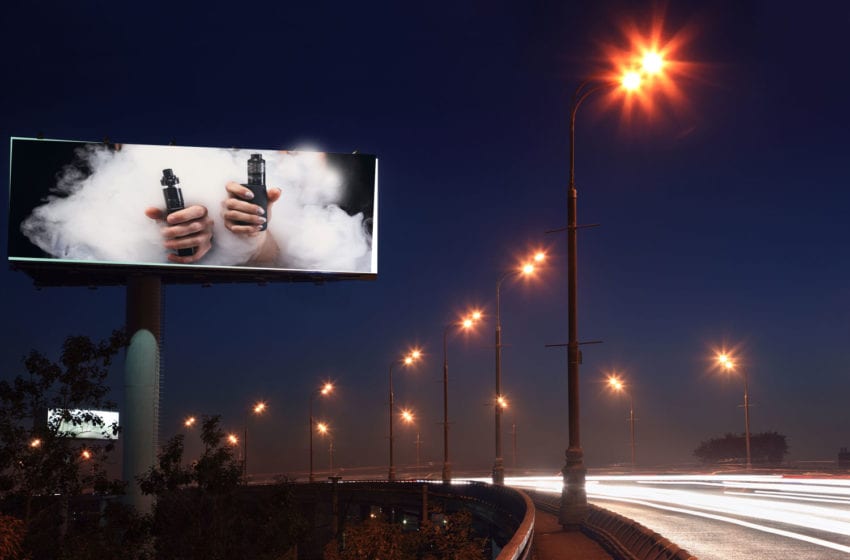
Powered by new data-driven planning platforms, “out of home” is emerging as the media channel of choice for legal and effective tobacco advertising.
By Shabnam Irilian
In the advertising world, there is likely no more heavily regulated industry than tobacco, where restrictions are onerous and plentiful. The advertising of traditional tobacco products has been banned from U.S. radio and television airwaves since the 1970s. Online advertising opportunities are minimal, with the most popular destinations and social media platforms—Google and Facebook, to name just two—also banning tobacco ads. And while vapor products and some newer alternative tobacco products do not always fall under these bans, there is a general reluctance among media owners and platforms to allow advertising for fear of a public or legal response.
With so few channels at their disposal, tobacco and nicotine brands often turn to “out of home” (OOH) advertising, which has long held strong appeal for companies operating within industries where marketing activities are restricted. They turn to OOH not just because of its availability but because of its ability to reach both larger mass audiences and smaller targeted ones as well. OOH is typically more cost effective, delivering greater cost per mille (the amount an advertiser pays a website per 1,000 views), which is ideal for emerging alternative tobacco brands that may not have deep pockets when it comes to advertising spend. Perhaps most importantly, OOH has a proven track record when it comes to influencing consumer attitudes and behaviors and spurring action.
But advertising using OOH does not come without challenges. For one thing, the industry itself is highly fragmented with multiple forms of inventory owned by a myriad of different media owners. There are currently 1.5 million screens and displays in the United States. Navigating an inventory of this size and dealing with the various owners is enough of a challenge for any brand, let alone one in a restricted category.
And speaking of restrictions, while OOH is certainly more available to tobacco and nicotine advertisers than other channels, brands and their agency partners must be aware of and operate within compliance of complex laws that govern where ads can be placed and content that can be displayed. These laws can vary dramatically from one state, city or municipality to the next, and they change with great frequency.
With all this in mind, the question turns to how tobacco and nicotine brands can leverage the OOH channel in the most effective, and legal, way. Here are some tips:
Combine compliance with sensitivity
The emergence of data-driven platforms has improved the OOH planning and buying process for all brands. For tobacco and nicotine brands, optimized platforms help identify compliant inventory, making the planning process even easier and faster. That said, just because you can do something doesn’t necessarily mean you should. Even if a particular screen is approved and legal for tobacco advertising, consider the environment and use common sense to determine whether your ad might be off-putting or create more problems for your brand than new customers gained.
Confront issues as a team with shared responsibility
As mentioned, the market for U.S. OOH inventory is highly fragmented, and the laws and restrictions governing advertising for tobacco companies are complex. Even with the best technologies and tools, it’s not impossible for problems to arise. Checking the box on compliant inventory during the planning process is not enough. Monitoring must and should continue throughout the duration of campaigns. Conduct drive-arounds where possible to visually confirm that your ads are properly placed within the context of the community. And work in tandem with your partners, from planners to buyers to creatives, to create an environment of shared accountability so that any problems that might arise can be addressed quickly and collaboratively.
Capitalize on all that specialists can offer
These days, it’s not uncommon to see stories of billboards being purchased by regular, everyday citizens for any number of reasons—marriage proposals, fundraising, congratulatory messages, etc. Yes, anyone can call a media owner and buy a billboard these days. But for brands that want to take a more strategic approach and drive real value from their investments in OOH, working with agency partners is the more advisable route, even more so for tobacco and nicotine brands that not only need to rely on the experience and expertise of industry experts but can benefit from the existing relationships agencies have with media owners to access premium inventory and favorable pricing. Plus, not only are OOH specialists equipped with the ability to select the compliant and legal inventory—they also have the data, tools and technology to overlay those selections with the inventory that will succeed in delivering the right message to the right audience at the right time, driving business outcomes.
Think of OOH as strategic
Finally, don’t think of OOH as the “nice-to-have” add-on to your broader strategic marketing efforts. OOH works well in concert with complementary campaigns and, when integrated with mobile and social media, can amplify the reach and value of your marketing efforts. Ensure that your OOH partners are involved in your strategic planning discussions at the very start of the process.












